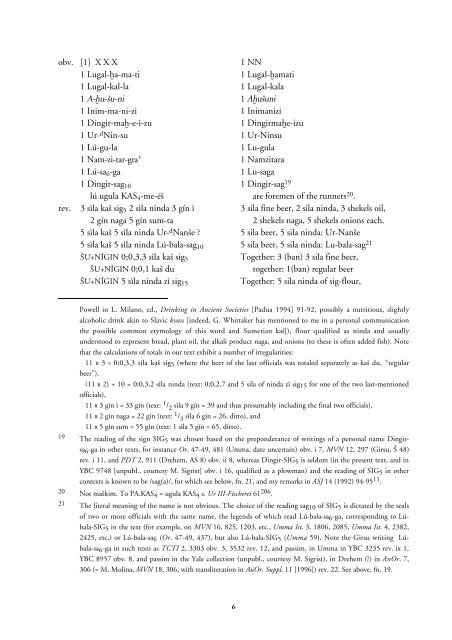PDF copy - Cuneiform Digital Library Initiative - UCLA
PDF copy - Cuneiform Digital Library Initiative - UCLA
PDF copy - Cuneiform Digital Library Initiative - UCLA
You also want an ePaper? Increase the reach of your titles
YUMPU automatically turns print PDFs into web optimized ePapers that Google loves.
obv. [1] X X X 1 NN<br />
1 Lugal-Ìa-ma-ti 1 Lugal-Ìamati<br />
1 Lugal-kal-la 1 Lugal-kala<br />
1 A-Ìu-Òu-ni 1 AÌuÒuni<br />
1 Inim-ma-ni-zi 1 Inimanizi<br />
1 Dingir-maÌ-e-ì-zu 1 DingirmaÌe-izu<br />
1 Ur-dNin-su 1 Ur-Ninsu<br />
1 Lú-gu-la 1 Lu-gula<br />
1 Nam-zi-tar-gra» 1 Namzitara<br />
1 Lú-sa6-ga 1 Lu-saga<br />
1 Dingir-sag10<br />
1 Dingir-sag19 lú ugula KAS4-me-éÒ are foremen of the runners20 .<br />
rev. 3 sìla kaÒ sig5 2 sìla ninda 3 gín ì 3 sila fine beer, 2 sila ninda, 3 shekels oil,<br />
2 gín naga 5 gín sum-ta 2 shekels naga, 5 shekels onions each.<br />
5 sìla kaÒ 5 sìla ninda Ur-dNanÒe ? 5 sila beer, 5 sila ninda: Ur-NanÒe<br />
5 sìla kaÒ 5 sìla ninda Lú-bala-sag10 5 sila beer, 5 sila ninda: Lu-bala-sag21 ∑U+NŸGIN 0;0,3,3 sìla kaÒ sig5<br />
Together: 3 (ban) 3 sila fine beer,<br />
∑U+NŸGIN 0;0,1 kaÒ du together: 1(ban) regular beer<br />
∑U+NŸGIN 5 sìla ninda zì sig15<br />
Together: 5 sila ninda of sig-flour,<br />
Powell in L. Milano, ed., Drinking in Ancient Societies [Padua 1994] 91-92, possibly a nutritious, slightly<br />
alcoholic drink akin to Slavic kvass [indeed, G. Whittaker has mentioned to me in a personal communication<br />
the possible common etymology of this word and Sumerian kaÒ]), flour qualified as ninda and usually<br />
understood to represent bread, plant oil, the alkali product naga, and onions (to these is often added fish). Note<br />
that the calculations of totals in our text exhibit a number of irregularities:<br />
11 x 3 = 0;0,3,3 sìla kaÒ sig5 (where the beer of the last officials was totaled separately as kaÒ du, “regular<br />
beer”),<br />
(11 x 2) + 10 = 0;0,3,2 sìla ninda (text: 0;0,2,7 and 5 sila of ninda zì sig15 for one of the two last-mentioned<br />
officials),<br />
11 x 3 gín ì = 33 gín (text: 1 / 2 sìla 9 gín = 39 and thus presumably including the final two officials),<br />
11 x 2 gín naga = 22 gín (text: 1 / 3 sìla 6 gín = 26, ditto), and<br />
11 x 5 gín sum = 55 gín (text: 1 sìla 5 gín = 65, ditto).<br />
19 The reading of the sign SIG5 was chosen based on the preponderance of writings of a personal name Dingirsa6-ga<br />
in other texts, for instance Or. 47-49, 481 (Umma, date uncertain) obv. i 7, MVN 12, 297 (Girsu, ∑ 48)<br />
rev. i 11, and PDT 2, 911 (Drehem, AS 8) obv. ii 8, whereas Dingir-SIG5 is seldom (in the present text, and in<br />
YBC 9748 [unpubl., courtesy M. Sigrist] obv. i 16, qualified as a plowman) and the reading of SIG5 in other<br />
contexts is known to be /sag(a)/, for which see below, fn. 21, and my remarks in ASJ 14 (1992) 94-95 11 .<br />
20 Not maÒkim. To PA.KAS4 = ugula KAS4 s. Ur III-Fischerei 61 206 .<br />
21 The literal meaning of the name is not obvious. The choice of the reading sag10 of SIG5 is dictated by the seals<br />
of two or more officials with the same name, the legends of which read Lú-bala-sa6-ga, corresponding to Lúbala-SIG5<br />
in the text (for example, on MVN 16, 825, 1203, etc., Umma Ist. 3, 1806, 2085, Umma Ist. 4, 2382,<br />
2425, etc.) or Lú-bala-sa6 (Or. 47-49, 437), but also Lú-bala-SIG5 (Umma 59). Note the Girsu writing Lúbala-sa6-ga<br />
in such texts as TCTI 2, 3303 obv. 3, 3532 rev. 12, and passim, in Umma in YBC 3235 rev. ix 1,<br />
YBC 8957 obv. 8, and passim in the Yale collection (unpubl., courtesy M. Sigrist), in Drehem (?) in AnOr. 7,<br />
306 (= M. Molina, MVN 18, 306, with transliteration in AuOr. Suppl. 11 [1996]) rev. 22. See above, fn. 19.<br />
6
















